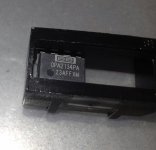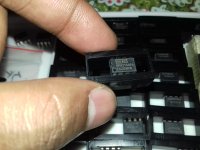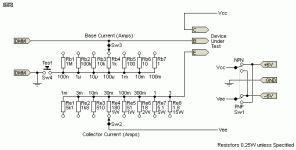Back in April 2022 I bought 20 pieces of TIP3055 and TIP2955 transistors from Mouser US.
Last week I opened the packaging - I wanted to select and match 2 pairs of devices.
To my surprise, transistor tester detected different pinout on them.
As with most BJT/Fet (except laterals) TO-247 devices, pinout is supposed to be B-C-E.
But here I see B-E-C.
Also Beta measured shows value of 12. Datasheet shows minimum Beta as 20.
Real TIP2955 I checked usually show value over 60-80.
I checked random 5 transistors from the batch of 20, and they all show the same thing.
TIP3055s seem to be 'normal'.
What this world came to? Even Mouser sells fakes now?
Mouser refuses to replace or refund them, as '90 day return window already passed'.
Buyers beware.

Last week I opened the packaging - I wanted to select and match 2 pairs of devices.
To my surprise, transistor tester detected different pinout on them.
As with most BJT/Fet (except laterals) TO-247 devices, pinout is supposed to be B-C-E.
But here I see B-E-C.
Also Beta measured shows value of 12. Datasheet shows minimum Beta as 20.
Real TIP2955 I checked usually show value over 60-80.
I checked random 5 transistors from the batch of 20, and they all show the same thing.
TIP3055s seem to be 'normal'.
What this world came to? Even Mouser sells fakes now?
Mouser refuses to replace or refund them, as '90 day return window already passed'.
Buyers beware.
Back in April 2022 I bought 20 pieces of TIP3055 and TIP2955 transistors from Mouser US.
Last week I opened the packaging - I wanted to select and match 2 pairs of devices.
To my surprise, transistor tester detected different pinout on them.
As with most BJT/Fet (except laterals) TO-247 devices, pinout is supposed to be B-C-E.
But here I see B-E-C.
Also Beta measured shows value of 12. Datasheet shows minimum Beta as 20.
Real TIP2955 I checked usually show value over 60-80.
I checked random 5 transistors from the batch of 20, and they all show the same thing.
TIP3055s seem to be 'normal'.
What this world came to? Even Mouser sells fakes now?
Mouser refuses to replace or refund them, as '90 day return window already passed'.
Buyers beware.
That is terrible... very bad and damaging for the Mouser's reputation.
Their claim that 90 days return period expired should be challenged here. The transistors can not change the specifications due to aging... the pinout can definitely not change.
The fact that TIP299 have the wrong pin-out is a dead giveaway they are fake. I reckon you should take that higher up the chain at Mouser.
I have had a similar experience from Mouser (Hong Kong), incorrect pin out of an optocoupler. Would have to be the whole manufacturing batch was faulty and that Mouser must have known this due to complaints received within the correct time. I now strongly suspect that the principals of Mouser are unprincipled and I will not use them again.The principles at Mouser will be very interested to hear about this. Tell them.
I paid for these TIP2955 around $40.00; they won't refund it - I can live without it,
but the real problem is that:
a) they can't be trusted anymore - we can't just blindly assume that their product is kosher, like I was doing so far
b) since they don't even admit that there is a problem - we can't expect this to get fixed.
but the real problem is that:
a) they can't be trusted anymore - we can't just blindly assume that their product is kosher, like I was doing so far
b) since they don't even admit that there is a problem - we can't expect this to get fixed.

Could this guy be in charge of purchasing at Mouser? https://www.theengineeringprojects.com/2020/09/introduction-to-tip2955.html
Anyways, they're sure going to love the free publicity.....not!
Looks like this transistor comes in all different variety of pinouts 🙂
Could this guy be in charge of purchasing at Mouser? https://www.theengineeringprojects.com/2020/09/introduction-to-tip2955.html
Anyways, they're sure going to love the free publicity.....not!
All combinations exhausted now. BCE, BEC, ECB....
I want to keep an eye on this thread. I would at least contact them back and tell them to forget the refund, but you want an answer as to what they’re selling. Any chance they’re tricking your tester?
I will say, I received some MJ21195G directly from Onsemi and some of them measured with a gain on 2, 6, 8, etc. while there were only a few like this the rest were 110-120. Maybe they’re manufacturer defects.
Dan
I will say, I received some MJ21195G directly from Onsemi and some of them measured with a gain on 2, 6, 8, etc. while there were only a few like this the rest were 110-120. Maybe they’re manufacturer defects.
Dan
Just to be certain, forget your smart tester and use plain old multimeter diode scales; what do you find?
Also kludge a crude Hfe tester: using a 5V supply inject 1mA into base using a 4k7 resistor an measure current passing from collector to +5V, what do you find?
As in: 10mA=10Hfe , and so on.
Too low current for a power transistor but it´s safe and will allow to check for consistency; you should have, say, 2:1 or 3:1 variations, not 10:1 or more
Also kludge a crude Hfe tester: using a 5V supply inject 1mA into base using a 4k7 resistor an measure current passing from collector to +5V, what do you find?
As in: 10mA=10Hfe , and so on.
Too low current for a power transistor but it´s safe and will allow to check for consistency; you should have, say, 2:1 or 3:1 variations, not 10:1 or more
Yes, at the very low test current available in the OP's microprocessor type of tester, you can't really verify the current gain of any power transistor. I get wildly different measurements within any batch too. However, on a heatsink with 1/2 to 1A flowing through the DUT, the specs start to come into focus.
I would never trust those microcontroller based cheap meters.
You can simplify this circuit using one resistor at the base and one resistor at the collector for the current that you interesting.
https://sound-au.com/project177.htm
Finally i can't beleive that Mouser sell fake parts.
You can simplify this circuit using one resistor at the base and one resistor at the collector for the current that you interesting.
https://sound-au.com/project177.htm
Finally i can't beleive that Mouser sell fake parts.
Attachments
Last edited:
for a few years I have tripled my transistor tests, a tester has. microcontroller base, a big analog B&K tester and finally the test component of my oscilloscope
I only used this tester to demonstrate the problem. I don't use it for matching transistors.
At least it detects pinouts correctly.
At least it detects pinouts correctly.
Power transistor, especially older technology devices, had quite a gain roll-off at low currents. You need to be able to test the gain at the specified current.Back in April 2022 I bought 20 pieces of TIP3055 and TIP2955 transistors from Mouser US.
Last week I opened the packaging - I wanted to select and match 2 pairs of devices.
To my surprise, transistor tester detected different pinout on them.
As with most BJT/Fet (except laterals) TO-247 devices, pinout is supposed to be B-C-E.
But here I see B-E-C.
Also Beta measured shows value of 12. Datasheet shows minimum Beta as 20.
Real TIP2955 I checked usually show value over 60-80.
I checked random 5 transistors from the batch of 20, and they all show the same thing.
TIP3055s seem to be 'normal'.
What this world came to? Even Mouser sells fakes now?
Mouser refuses to replace or refund them, as '90 day return window already passed'.
Buyers beware.
View attachment 1129150
If your meter thinks the connections are wrong, you meter may have the C and E reversed. That would certainly give a low gain reading.
If you have a 5V power supply, try putting the transistor onto a heatsink and with a low value resistor to limit the current (say 10 ohms 2W) connect it up as it should be (collector in centre) and see if you get a measurable voltage drop (that means current flow) when putting another, higher value resistor between the supply voltage (negative) and the base. At 100mA say, you should get a 1V drop across the collector resistor with a base resistor in the region of 1k.
Though the data sheets used to have typical gain curves, recent ones seem to have dropped such useful data. The older data sheets I have from Bourns (just after they took over TI) suggests a gain of 100 at 1-100mA, but a low gain production device COULD have lower gains and still meet "20 at 4A" spec.
This does not rule out the possibility of your devices being fake, but it may explain the poor readings - just a low end production run.
What is the manufatruing logo of the device? Does that seem genuine? I think ON Semi and ST still manufacture these, among others.
1) ST
2) As mentioned before - I don't use this meter to measure anything - I only use it as a basic test to see if transistor is Ok.
For this purpose, I trust this meter. It detects pinouts perfectly, and it detects burned/shorted transistors.
That said - this meter was showing expected results (pinout/beta) on all other TIP transistors (from several batches/sources) I believe to be genuine.
3) This meter was only used to visualize the problem with pinout.
Please don't turn this thread into "How to properly measure stuff", because that's not the point.
4) I have another rig designed for matching power transistors for Vbe, and I confirmed that the pinouts on these fake TIP2955 are indeed B-E-C
2) As mentioned before - I don't use this meter to measure anything - I only use it as a basic test to see if transistor is Ok.
For this purpose, I trust this meter. It detects pinouts perfectly, and it detects burned/shorted transistors.
That said - this meter was showing expected results (pinout/beta) on all other TIP transistors (from several batches/sources) I believe to be genuine.
3) This meter was only used to visualize the problem with pinout.
Please don't turn this thread into "How to properly measure stuff", because that's not the point.
4) I have another rig designed for matching power transistors for Vbe, and I confirmed that the pinouts on these fake TIP2955 are indeed B-E-C
Last edited:
It's very hard for a power transistor not to have the collector in the middle, the collector is always the substrate and soldered to the main tab.
Could this guy be in charge of purchasing at Mouser? https://www.theengineeringprojects.com/2020/09/introduction-to-tip2955.html
Anyways, they're sure going to love the free publicity.....not!
The only exceptions that I know are RF power devices, which put the emitter to case
You were the one complaining that the gain was low at 12 not 20. All I was pointing out was that the gain spec. of 20 is at 4A, which I doubt is the current at which your meter is measuring it at.
That led me to wonder whether your meter is measuring it correctly, especially if it thinks the connections are reversed.
Perhaps rather than criticise my reply you would check the transistors against the data sheet?
As I mentioned, it is possible that current gains below the rated specification could be lower than "typical" as there are no minimum gain specifications at other currents except 10A which is probably not too relevant, although if you are testing transistors against the data sheet may be another measurement to be made.
And I'd agree with setting the emitter current as a better option for measuring current gain but that usually means two meters, which is what I normally would use.
Having seen davidsrsb's response, I concur, and you should check the centre lead with the tab connection.
That led me to wonder whether your meter is measuring it correctly, especially if it thinks the connections are reversed.
Perhaps rather than criticise my reply you would check the transistors against the data sheet?
As I mentioned, it is possible that current gains below the rated specification could be lower than "typical" as there are no minimum gain specifications at other currents except 10A which is probably not too relevant, although if you are testing transistors against the data sheet may be another measurement to be made.
And I'd agree with setting the emitter current as a better option for measuring current gain but that usually means two meters, which is what I normally would use.
Having seen davidsrsb's response, I concur, and you should check the centre lead with the tab connection.
Last edited:
The meter itself may be acting stupid at low currents. It could very well get confused if the forward beta it tries to measure is low. It may be reporting a reverse beta (which is normally lower, but may not be at the very low test current). Look at the beta at tens of mA and it may look normal. Lacking good test equipment, just drive a 12 volt light bulb through the collector and see if a reasonable base current will turn it all the way on.
Ive measured single digit beta on “good” transistors at 1 uA Ib. They do tend to be bottom of the barrel, but could pass for a good device at normal currents. TIP types have such a broad spec range about anything could get through. The 3055/2955 isn’t much different than the usual TIP range. What they sell as a “TIP2955” doesn’t have to be as “good” as a “MJ2955” or “MJE2955”.
The only thing that I might see as “fishy” is the fact that this particular behavior pattern is more typical of NPN transistors than it is PNPs. I’d just test a couple under more normal conditions and see where they end up. If they do turn out to be fakes, it’s usually the manufacturer who would rather deal with it. Might not give you money back, but they may want them to aid in tracking down who’s spoofing them and how they got into the supply chain.
Ive measured single digit beta on “good” transistors at 1 uA Ib. They do tend to be bottom of the barrel, but could pass for a good device at normal currents. TIP types have such a broad spec range about anything could get through. The 3055/2955 isn’t much different than the usual TIP range. What they sell as a “TIP2955” doesn’t have to be as “good” as a “MJ2955” or “MJE2955”.
The only thing that I might see as “fishy” is the fact that this particular behavior pattern is more typical of NPN transistors than it is PNPs. I’d just test a couple under more normal conditions and see where they end up. If they do turn out to be fakes, it’s usually the manufacturer who would rather deal with it. Might not give you money back, but they may want them to aid in tracking down who’s spoofing them and how they got into the supply chain.
- Home
- Design & Build
- Parts
- Fake TIP2955 from Mouser?


